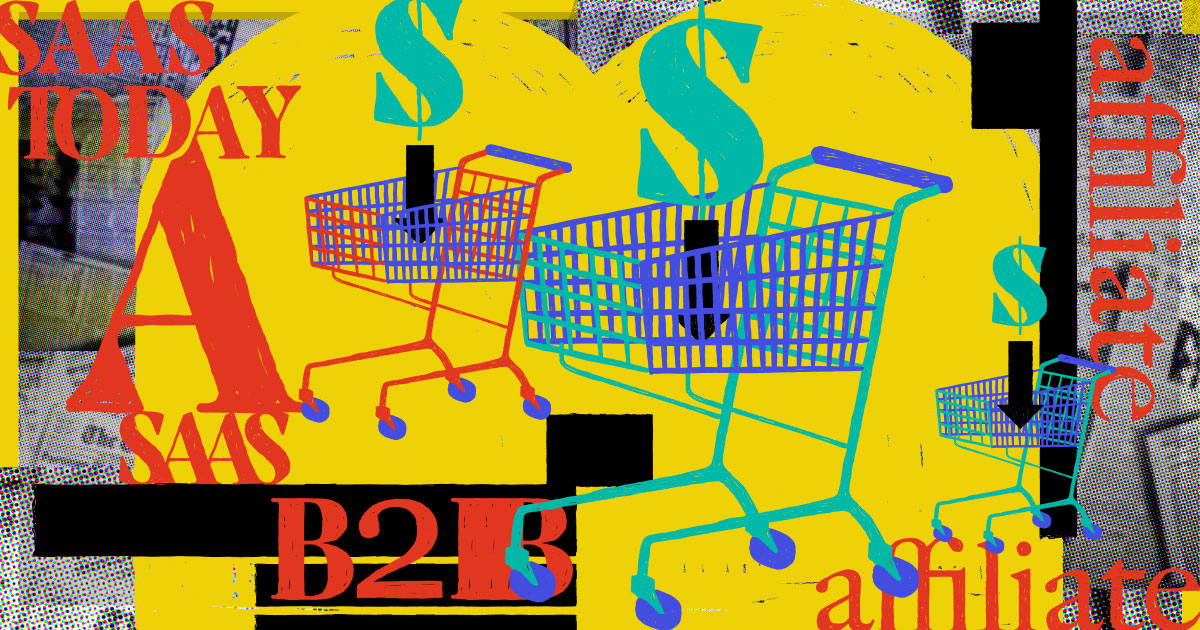With tech ecosystems redefining the partnerships industry, going to market looks different these days. We’re in a time where no one owns their customer, competitors are colleagues, and companies share intellectual property with other companies in order to co-build solutions.
The shift towards an ecosystems-driven business world is changing how companies sell, and in this new world, working with outside entities during the sales process is essential.
Further, 76% of business leaders say that current business models will be unrecognizable in the next five years, according to Accenture. The main reason for this transformation will be ecosystems. Direct sales teams will hand over the torch to (or evolve into) partnered sales teams — and these co-sell partnerships will be one to many as opposed to one to one.
In this environment, co-selling sales teams are essential. We spoke with PartnerStack’s Manager of Channel Partnerships, Nicolette Lopes, to learn about the important role that co-selling plays in an ecosystem. Read on to learn what co-selling is, what it’s not, how it differs from current sales processes, and how to successfully pull co-selling off within your own partner ecosystem.
What is co-selling and how does co-selling work within a partnership ecosystem?
Simply put, co-selling is the act of bringing in a third party to support and close a deal. It’s like a sales team that consists of people from multiple companies as opposed to just one.
Suppose you’re the sales director at a company that sells database application software. You go to a healthcare organization and tell them that your company’s software is the perfect fit for their business needs. They’re intrigued, but they’re not sold just yet.
To help ease their concerns, you bring in an external person. This person is an employee at a systems integrator. As a temporary member of your sales team, they explain that this is actually the best solution on the market for the healthcare organization’s use case.
This systems integrator lends credibility, because it has worked with both your company and your company’s competitors. They’ve also worked on database software application implementations for other healthcare companies.
All of this put together gives the prospect confidence that they should purchase the solution. This is an example of a co-selling sales team. But why is co-selling necessary in the first place?
“Statistically speaking, buyers do not trust sales reps. If a buyer is going directly to a sales rep, they assume that the sales rep is giving them false information, overselling the product, maybe they’re not able to fully represent the tech itself,” explains Lopes. “Given today’s buyer behavior in SaaS, buyers are able to do so much of the work in procuring software before they ever actually talk to the brand. There is significant value in being able to inject a partner who is able to reach and influence your clients before you have the ability to.”
The database software example we described above is an example of ad hoc co-selling within a sales team. In that example of co-selling, you as the sales director may just be a proactive high performer who has nurtured relationships over a long career and can invite experts from other companies into your sales team’s conversations. You may have understood that the prospect needed a little social proof. While this does wonders for deals that you’re involved in, it stays locked within your world rather than spreading to the rest of the organization.
In reality, co-selling is more structured. Companies that know they work well together — like the database application software vendor and systems integrator in this example — could have a pre-existing relationship that reduces the amount of downstream work a sales professional has to do to close the deal.
The prospect can come in already knowing that:
- they’ve chosen the right solution for their specific business need, and
- they have an expert who can help them implement it, so they can start enjoying the business value immediately
There are also partner managers who help facilitate these deals.
What is the difference between co-selling and re-selling?
Co-selling and re-selling sound similar. While they might sound like they mean the same thing, they’re actually quite different. To tell the difference, just ask yourself: who actually pays for it? “The distinction here is really in who owns the client and who manages the contracting. When we talk about co-selling, this can often take a number of different forms. It's important to align with each of your co-sell partners individually to determine who will do what within a deal cycle and how the co-sell partner will be expected to support. This may include a ramp period, not dissimilar to a new direct sales hire, and over time may become a very self-sufficient source of revenue,” Lopes explains.
“However, having your co-sell partners take on vendor contracting may not always be feasible for one reason or another. Enter resellers. Resell partners take margin vs the co-sell motion who typically relieves a commission, but they often provide much less in-deal visibility. Your relationship with your resellers are paramount here, especially if you are in an organization who is used to having full control over the incoming revenue to the business.” she explains.
Related: How app marketplaces help B2B partner ecosystems thrive with revenue.

What are the benefits of co-selling in your ecosystem?
Co-selling introduces benefits for everyone within your ecosystem, and they go beyond straightforward channel partnerships. First, co-selling allows deals to happen faster, at lower cost, and while generating greater value.
As Jay McBain explained in his conversation with Partner Insight, the tech industry, specifically SaaS, is no longer at a place where it’s worried about hiding the total cost of ownership (TCO) of a solution. If a customer wants to buy, it’s “not the 20% of the deal that a partner can go win…it’s the 200 or 300% of the deal that they can go win at 75% margin.”
Customers get a one-stop-shop and all of the companies involved in the co-sell partnership get a larger recurring revenue stream at a cheaper acquisition cost.
How do you practice co-selling within your ecosystem?
Want to start leveraging the power of co-selling in your ecosystem? Follow these steps.
Make sure you can dedicate time and resources before getting started
The co-selling process isn’t something you can simply delegate to an existing member of your team. If they are already producing marketing resources or conducting direct sales, tacking “co-selling process management” or “channel partnership management” onto their existing responsibilities risks a mediocre partner ecosystem co-sell program without the right resourcing.
“We see it a lot,” explains Lopes. “They’ll repurpose one individual from somewhere on the go-to-market team and say, ‘Okay, this is half your job now. Keep doing your entire other job, but now also focus on building an entire partnership function.”
Why is this important? Because co-selling and co-selling within an emerging ecosystem takes time and effort, and partners can tell when a vendor is not committing adequate time or energy to them. Because they work with so many vendors, it is not difficult for them to spot a subpar partner co-sell program. Despite this, companies often want to wait until something breaks before they take action and commit real time to their partner program.
“What ‘breaking’ means is that your partners are pissed off at you, your partners start firing you, deals start falling through, and that’s when you then realize, ‘Hey. We actually need to take this seriously.’” says Lopes. “When that happens, you’ve lost those relationships. They are not going to come back and work with you after you’ve burned the bridge.”
Since it’ll be difficult to get all of the technology set up at the beginning of your partner program, having a dedicated person who can engage with a partner’s sales team, listen to them, and ensure they are heard is important.
Another way for companies to get started is to look at the “shadow” co-selling that’s already happening within the company. “People ask, ‘Where do you find these partners?’ The first place you should look is within your business,” says Lopes. “The reality is that partners are already influencing customers to work with you. You may just not be treating them like partners yet.”
Lopes explains that SaaS companies can often go into their Slack channel, or other internal communication tools, to discover underlying partner motions working within the business.You will likely discover a number of threads along the lines of “Hey, we have a current customer who wants to introduce us to someone. What rep should I loop in?” This is a referral partner, not a direct sale motion.
She also points to instances where SaaS companies are doing an implementation with someone for a SaaS solution, but their email domain is different than the ISV who is the end customer. This reveals the people helping to implement specific solutions, aka partners, that they should be working with.
“There’s a lot of that living under the surface,” Lopes continues. “It’s just a matter of going to your customers to understand, ‘How did you buy us? What did that process look like? Who did you leverage or lean on for industry insights? Are you working with someone now to help you? And then working with those people to maximize the relationships.”
Identify your ideal partner
Next, you’ll need to identify who your ideal partner is. Ideal partner profiles (IPPs) aren’t new in the partnerships world, but when applying them to co-sell relationships, we recommend layering in another step: analyzing your organization in terms of its fit for your ideal partner. Conduct a SWOT analysis to identify:
- Strengths
- Weaknesses
- Threats
- Opportunities
For instance, if you’re a technology company with an excellent product (strength) but a weak implementation process or customer success team (weakness), there’s the threat that another business will come in and offer a smoother experience with a rival product. Your opportunity here is to tap into new markets (and deepen relationships within your existing market) by enhancing the experience around using your product.
This will also help you identify your unique value proposition. For instance, if your product is as good as you think, it solves a problem that managed service providers or systems integrators regularly have to solve for their customers. These are potential partners who would be happy to co-sell solutions to their customers, expanding the number of organizations that you can access.
Clarify exactly how much support you can provide
What exactly will you be offering to your partners? Will they have access to an ecosystem business management platform that makes it easy for them to track deals and share and access information? Will there be an employee who’s specifically responsible for co-selling relationships who will guide them if they ever need assistance? Will there be a learning management portal that gives them access to product information and training?
Make it clear what this partner relationship will look like so there are no unrealistic or unmet expectations around your program. Again, partners are wary of “landing page only” co-sell partnerships, and the explosion of digital companies means they are spoiled for choice. In fact, 77% of partners report that they have more choices when it comes to providers than they did three years ago.
“People or organizations who are familiar with this co-sell model, they know what a good partner program looks like and they know what a bad one looks like. Its important to understand that your prospective partners have options, and those options are your competitors. Partners will not invest in an organization who is not investing in them and often, vendors learn this lesson the hard way,” Lopes says. “It's not that you need to have everything 100% ready prior to launching your partner program, but it is important to prioritize partner success early on. This often means getting your partner's insights into your product, your market position, your co-marketing approach. Your partners have the relationship with your end customers, lean on them to better understand how they are winning the business before you are.’”
Map out potential accounts and create account plans for your co-sell strategy
Once you’ve engaged with your ideal partner, get together to map out potential co-sell opportunities. This is a list of potential customers that you feel would be perfectly suited for your co-selling arrangement. Include people from different departments (e.g., sales, marketing, product) in this conversation to get a full picture.
After you’ve done this, map out who has the strongest relationships with these potential customers and who should initiate these conversations. Once you’ve done this, develop account plans for each of these potential customers. This should include potential pain points, what kind of co-created solutions will resonate most with this audience, when to make introductions to the other partner’s sales team in the co-selling arrangement, and specific KPIs for tracking success.
Develop co-marketing plans for your co-sell strategy
You and your partner may have determined that you’re a perfect match, but that doesn’t mean the market knows this. If you want to have a successful co-selling relationship, your partner manager will need to develop a co-marketing plan. This plan will outline the business goals and the joint message you want to deliver to your target audience. The tangible outcomes of this plan might include:
- A co-branded landing page or website
- A co-branded digital marketing campaign (e.g., paid ads, social media ads, eBooks)
- Guest blogging on your partner’s site (and vice versa)
- Podcast interviews
- Press releases
The goal is to build awareness of this useful, co-created solution within your target market. This is also where social selling can come into play. Unlike social media marketing, social selling is about sales people building deeper relationships with the people in their network through social media. Some have even called it a way to replace cold calling. This social selling can be done through a company’s brand page or even by individual sales representatives developing deep one-to-one conversations online, so that their brand is the first one customers think of when they’re considering a purchase.
Co-selling is also a great opportunity to introduce team selling. Team selling is where multiple people work together to close an account, rather than one sales representative taking ownership of the account themselves. It could also be a team member from a specific department (such as product or engineering) who can answer specific questions a customer has and inspire confidence. Co-selling partners extend the number of team players you can bring into a call as well as the expertise each of those team players brings.
Read more: How to become an ecosystem-led company.

Measure your co-selling partner relationship
Define metrics and KPIs for your co-selling partner relationships so that you always have data to return to in order to refine your programs. Important metrics to track are:
- The number of qualified leads your co-selling partnerships have produced
- The dollar value of each qualified lead your co-selling agreements have produced
- Pre-qualified leads that your co-selling agreements have introduced into your pipeline
- How much revenue you’ve realized from partner-sourced deals
- How much different partners contributed to a specific deal (which informs how much of a cut they get from the deal)
- The average deal size that each partner brings in
Use your data to continue to improve and refine your program
As you build your co-selling relationships with your partners, you’ll gather more data, understand which partners bring the most value, and identify opportunities to adjust your compensation. This is also an important way to start adding to your program without biting off more than you can chew. For instance, you may find that your partners have trouble accessing support when it comes to selling or servicing your products. Providing a better technical support solution, like a dedicated line or inbox, might be something that enriches your partner program during the next iteration.
The best way to gather this data is by purchasing a partner ecosystem management platform. Co-selling requires modern platforms and traditional partner platforms no longer cut it. The PartnerStack platform offers one cohesive solution that powers a company’s entire ecosystem. This allows partner teams to focus on relationship building and avoid operational errors (such as failing to properly allocate a deal to the partner that brought it in) that erode trust.
What are common co-selling mistakes to avoid?
As you’re building your co-selling program, you may find yourself stumbling from time to time. Here are a few pitfalls to avoid.
According to Lopes, the biggest mistake you can make is not operationalizing your program sooner. This means not putting people and technology in place. Co-sell can’t run itself. You need a channel manager and someone who’s going to be there to physically support your partners through the sales cycle, be available for them, get them timely technical support, and make sure that they can continue to come across as the industry expert to the clients.
Eventually, you want to get to the point where you have an entire partner team. This partner team can manage different arrangements (e.g., co-selling, co-marketing, co-innovation, strategic partnerships). And ideally, this partner team won’t exist in a silo. They’ll be spread throughout the organization and regularly interact with other teams.
Partner co-selling leaders that you can use as inspiration
One of the most famous examples of a company embracing co-selling is Microsoft. Launched in the nineties, today Microsoft has a robust ecosystem that consists of hundreds of thousands of partners. Over 90% of Microsoft’s revenue comes from its partners. If you’re building your ecosystem, this should be proof enough of the impact partner-influenced revenue can have. So for a company that is lightyears ahead when it comes to developing an ecosystem, how do they think about co-selling?
For starters, they make it clear what they consider co-selling. For Microsoft, co-selling activities include building market demand, sharing leads, sales planning, accelerating partner-to-partner sales, delivering solutions through the marketplace, and more.
They also identify what kinds of co-selling opportunities are available. These different co-selling statuses ensure that businesses at different levels can participate in the Microsoft partner program without overwhelming the system:
- Co-selling with the Microsoft sales team: Working directly with Microsoft employees to meet a customer’s needs, either by selling something the customer has built on Microsoft, selling a service that supports Microsoft technology, or both.
- Partner to partner co-selling: Working with another partner in the Microsoft ecosystem to solve a customer’s problem.
- Private deal: Telling Microsoft what a company is working on using Microsoft technologies so Microsoft can keep tabs on it.
- Solution Assessment (SA): Working with partners to assess the technology needs of different businesses.
Partners are also given different co-selling statuses that determine the kind of co-selling support they will receive from Microsoft:
- In market: A partner has a solution in the marketplace, but they haven’t met the requirements to be considered “co-sell-ready.” Requirements include having a Partner ID, completing a business profile, and publishing the offer on the commercial marketplace among others.
- Co-sell-ready: The customer has met the requirements to be considered co-sell ready. Once a partner’s considered co-sell ready, their solution is shared with Microsoft sales teams and has the chance to reach a wider market of Microsoft and Microsoft-managed customers.
- Azure IP co-sell incentive: These customers have met the co-sell-ready requirements in addition to meeting a revenue threshold, a Microsoft technical validation, and a reference architecture diagram review. When customers reach this status, Microsoft sellers and partners work together to sell their solution that was built on Microsoft.
Does your co-selling program have to be as robust as Microsoft’s? Not immediately. But you can use it as inspiration for where your co-selling program (and ecosystem!) can eventually be. The ethos of the Microsoft partner ecosystem is ensuring partners benefit more from Microsoft. If you can build an environment in which it pays to work with your technology, you can win more deals, at a higher value, and at a lower cost.
Interested in learning more? Book a demo to learn how the PartnerStack platform can support your ecosystem’s growth.











